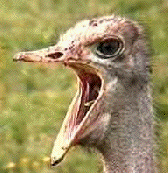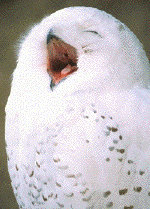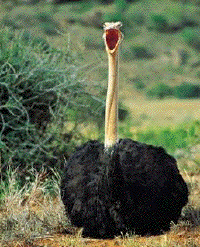  - Yawning
and other maintenance activities in the South
African Ostrich
- EG Franz Sauer, EM Sauer
The Auk1967; 84;
571-587
- Department of
zoologyUniversity of
FloridaGainesville
-
- The term "maintenance behavior" is used here
to describe activities that help regulate the
physiological state of the organism. When given
in the presence of another organism certain
maintenance activities may have secondary
communicative effects through "sympathetic
induction" causing social facilitation; for
example, some complex and derived maintenance
activities, such as the collecting of food by
individuals and groups for the benefit of all
participants or their dependents, have become
social events in both primary and ritualized
contexts.
-
- Yawning
and stretching are examples of basic
regulatory behavior for the purpose of
maintenance of bodily functions. One should
ignore neither the existence and releasing
values of specific, environmentally controlled
releasing mechanisms nor the social implications
of yawning and stretching in species
-
- Maintenance activities are common among all
vertebrates, and yawning and stretching are
general behavioral attributes of the homeotherms
as the poïkilothems. Among birds, as well
as among mammals, yawning is so wide-spread
that it is difficult to understand why it has
not become better known. Maintenance
behavior in birds is easily observed:
particularly when the ontogeny of an organism
and its behavioral systems are carefully
studied, one has no difficulty in identifying
the patterns of maintenance behavior. However,
students of bird behavior are commonly more
interested in other behavior patterns, such as
social behavior or migration, and the
establishment of ethograms, the complete
behavioral catalogues for individual species, is
badly neglected. The organic and physiological
bases of bird behavior are usually overlooked
and also largely unknown. However, a knowledge
of these underlying mechanisms is required for a
full understanding of maintenance behavior and
as a basis for experimental analysis of such
behavior. You can now read this
original work about Ostrich. (PDF
format)
-
- Le
bâillement et autres "maintenance
behavior" chez
l'autruche
-
- Le terme de "comportement de maintien et
d'entretien" ("maintenance behavior") est
utilisé ici pour décrire des
activités qui participent aux
régulations des fonctions de l'organisme.
En présence de congénères,
certaines de ces actvités peuvent, "par
réplication", participer d'interactions
sociales. Ainsi la recherche de nourriture peut
déboucher sur une mise en commun et
partage des ressources au profit de la
collectivité, le besoin de chaque
individu enrichissant ainsi rituellement les
liens au sein d'un groupe.
-
- Baillements
et étirements, par exemple, sont
des fonctions physiologiques de
régulation homéostasique
nécessaires à la survie. On ne
peut ignorer ces fonctions basales ni les
implications sociales qu'elles engendrent. Ce
type de comportements est commun à tous
les vertèbrés; baillements et
étirements existent tant chez les
homéothermes que chez les
poïkilothermes. Chez les oiseaux, comme
chez les mammifères, le
bâillement est si
généralisé qu'on ne peut
que s'étonner qu'il ait soulevé si
peu d'intérêt
d'étude.
-
- Alors que ces comportements peuvent assez
facilement être identifiés et
observés, en particulier au cours de
l'ontogénèse, les études
des oiseaux se sont beaucoup plus
orientées sur les interactions sociales
et les migrations, l'établissement
d'éthogramme, catalogue complet des
comportements d'une espèce, et ont
négligé les études des
fonctions comportementales concourant aux
régulations vitales individuelles. Vous
pouvez maintenant lire
l'intégralité de ce patient
travail
d'observations des Autruches. Télécharger
ce texte au fomat pdf.
-
-
- Yawning in the
Greenfinch Harrison JO, AUK 1968; 55;
511
- Uber
das Gähnen bei Vögeln Bergmann H
Die Vögelwelt 1966;87(5):134-138
- Zur
Frage des Gähnens bei der Vögel
Löhrl H Die Vögelwelt
1967;88(3):85-86
-
|





